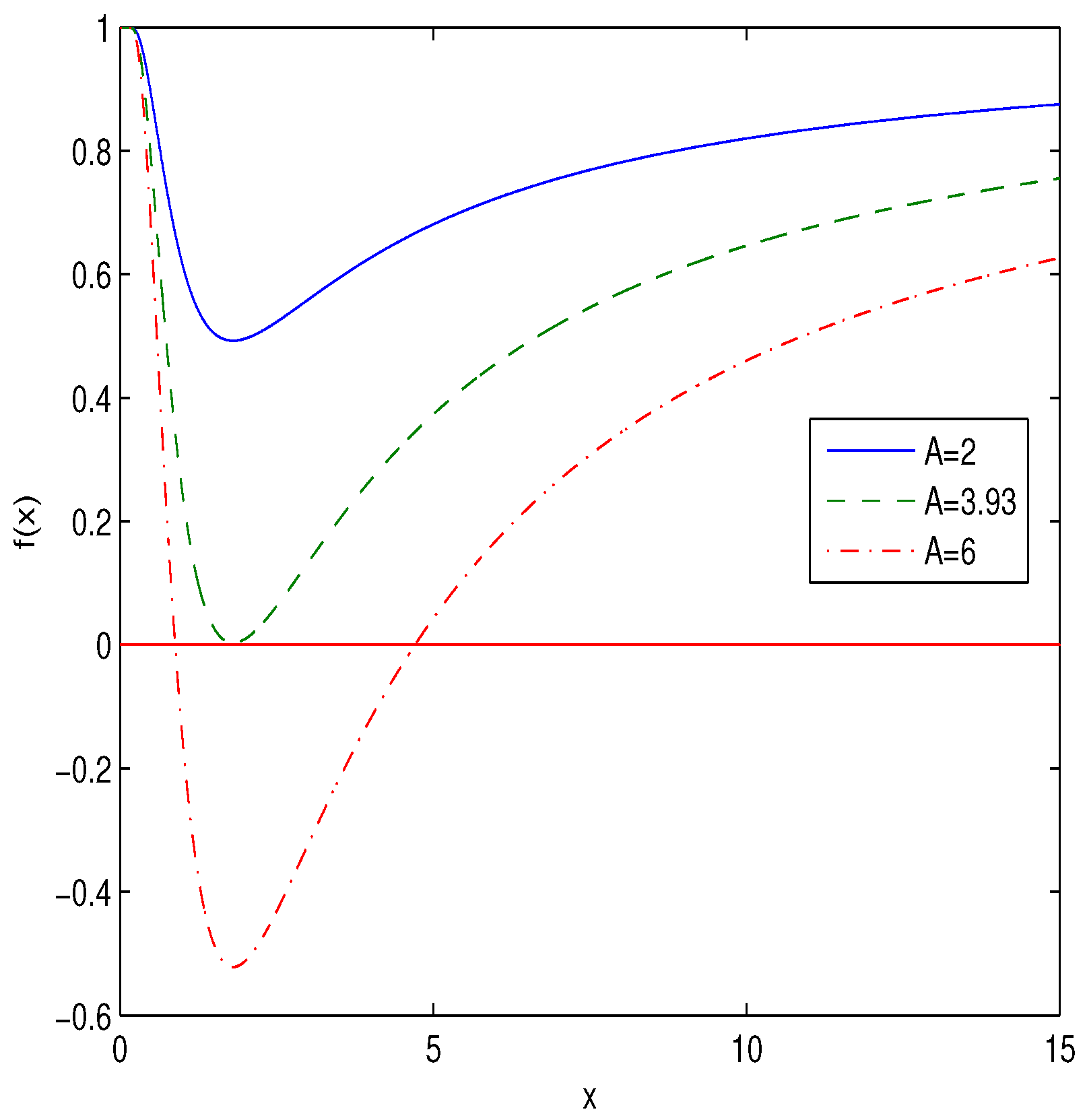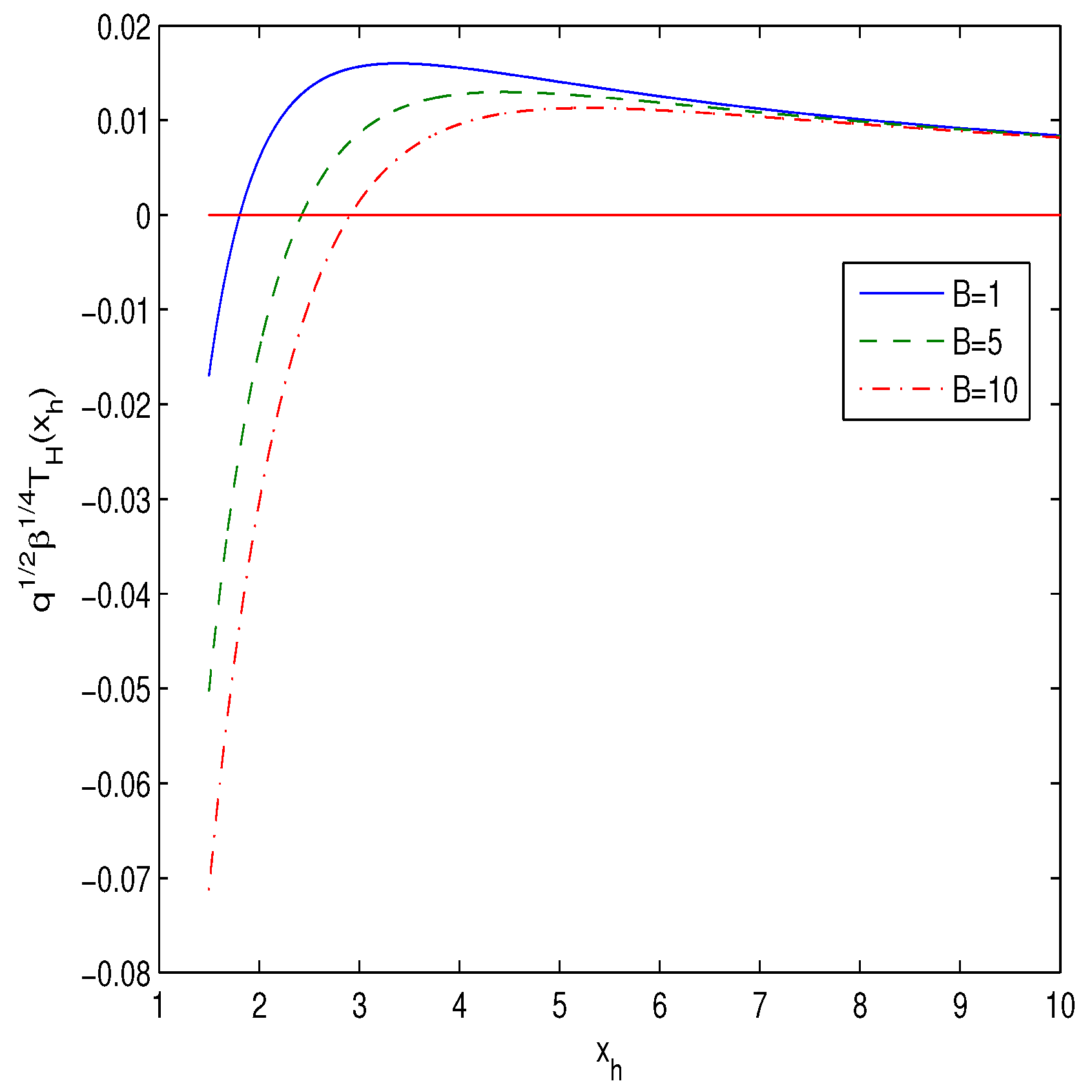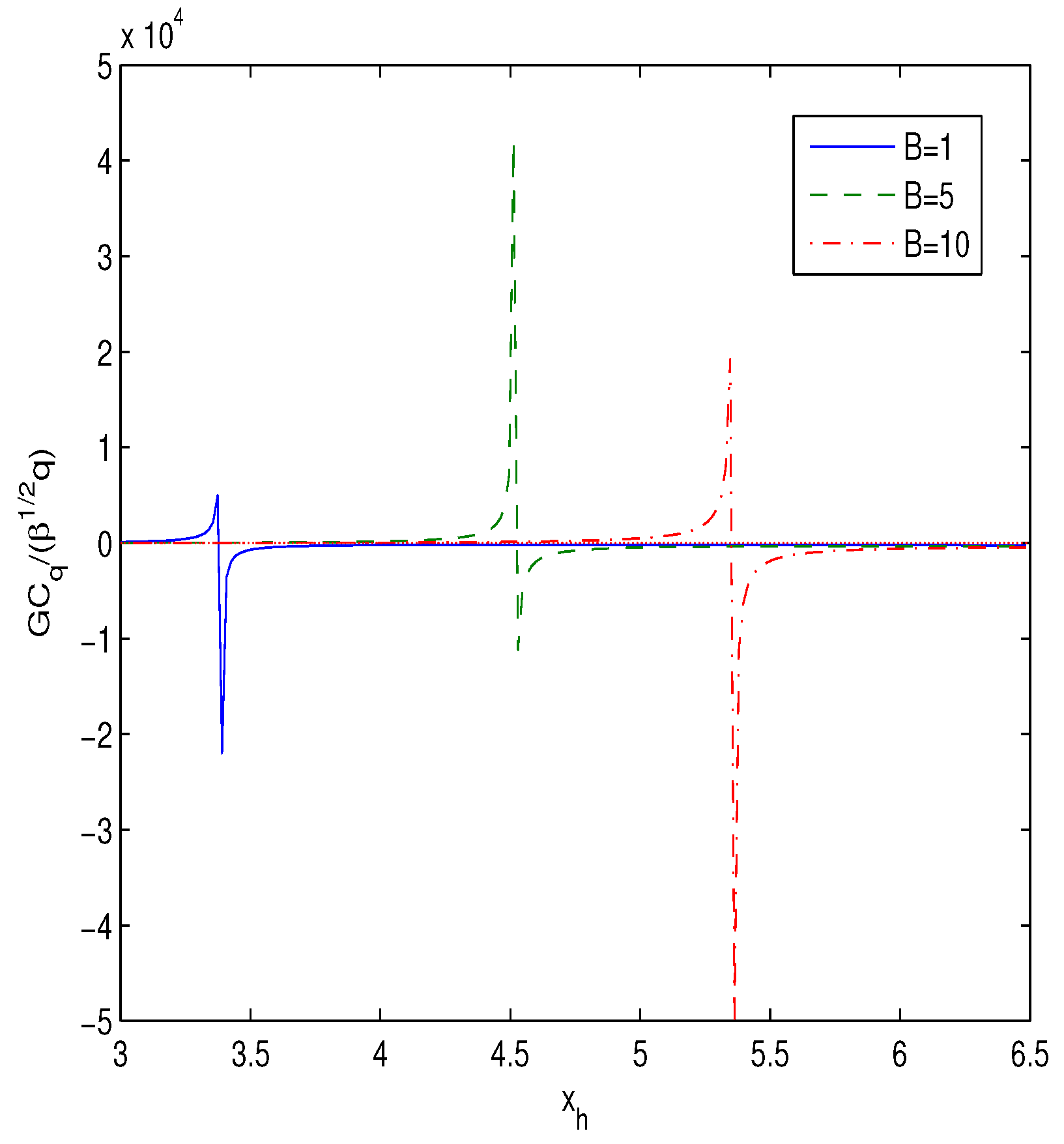Non-Singular Model of Magnetized Black Hole Based on Nonlinear Electrodynamics
Abstract
1. Introduction
2. A Regular Magnetized BH Solution
3. Thermodynamics and Phase Transitions
4. Conclusions
Funding
Conflicts of Interest
References
- Stelle, K.S. Classical gravity with higher derivatives. Gen. Rel. Grav. 1978, 9, 353–371. [Google Scholar] [CrossRef]
- Stelle, K.S. Renormalization of Higher Derivative Quantum Gravity. Phys. Rev. D 1977, 16, 953–969. [Google Scholar] [CrossRef]
- Biswas, T.; Gerwick, E.; Koivisto, T.; Mazumdar, A. Towards singularity and ghost free theories of gravity. Phys. Rev. Lett. 2012, 108, 031101. [Google Scholar] [CrossRef] [PubMed]
- Biswas, T.; Conroy, A.; Koshelev, A.S.; Mazumdar, A. Generalized ghost-free quadratic curvature gravity. Class. Quant. Grav. 2014, 31, 015022. [Google Scholar] [CrossRef]
- Modesto, L. Super-renormalizable Quantum Gravity. Phys. Rev. D 2012, 86, 044005. [Google Scholar] [CrossRef]
- Markov, M.A. Limiting density of matter as a universal law of nature. JETP Lett. 1982, 36, 266. [Google Scholar]
- Markov, M.A. Problems of a perpetually oscillating universe. Ann. Phys. 1984, 155, 333. [Google Scholar] [CrossRef]
- Polchinski, J. Decoupling Versus Excluded Volume or Return of the Giant Wormholes. Nucl. Phys. B 1989, 325, 619–630. [Google Scholar] [CrossRef]
- Frolov, V.P. Notes on nonsingular models of black holes. Phys. Rev. D 2016, 94, 104056. [Google Scholar] [CrossRef]
- Hayward, S.A. Formation and evaporation of nonsingular black holes. Phys. Rev. Lett. 2006, 96, 031103. [Google Scholar] [CrossRef]
- Bardeen, J. Non-singular general-relativistic gravitational collapse. In Proceedings of the GR5, Tbilisi, U.S.S.R., 9–13 September 1968. [Google Scholar]
- Ayon-Beato, E.; Garcia, A. The Bardeen model as a nonlinear magnetic monopole. Phys. Lett. B 2000, 493, 149. [Google Scholar] [CrossRef]
- Ayon-Beato, E.; Garcia, A. Regular black hole in general relativity coupled to nonlinear electrodynamics. Phys. Rev. Lett. 1998, 80, 5056. [Google Scholar] [CrossRef]
- Ayon-Beato, E.; Garcia, A. New regular black hole solution from nonlinear electrodynamics. Phys. Lett. B 1999, 464, 25. [Google Scholar] [CrossRef]
- Bronnikov, K.A. Regular magnetic black holes and monopoles from nonlinear electrodynamics. Phys. Rev. D 2001, 63, 044005. [Google Scholar] [CrossRef]
- Born, M.; Infeld, L. Foundations of the new field theory. Proc. Royal Soc. (Lond.) A 1934, 144, 425. [Google Scholar] [CrossRef]
- Gitman, D.M.; Shabad, A.E. A note on “Electron self-energy in logarithmic electrodynamics” by P. Gaete and J. Helayël-Neto. Eur. Phys. J. C 2014, 74, 3186. [Google Scholar] [CrossRef]
- Kruglov, S.I. A model of nonlinear electrodynamics. Ann. Phys. 2015, 353, 299. [Google Scholar] [CrossRef]
- Kruglov, S.I. Nonlinear arcsin-electrodynamics. Ann. Phys. (Berlin) 2015, 527, 397. [Google Scholar] [CrossRef]
- Kruglov, S.I. Modified nonlinear model of arcsin-electrodynamics. Commun. Theor. Phys. 2016, 66, 59. [Google Scholar] [CrossRef]
- Heisenberg, W.; Euler, H. Folgerungen aus der diracschen theorie des positrons. Z. Physik 1936, 98, 714. [Google Scholar] [CrossRef]
- García-Salcedo, R.; Breton, N. Born–Infeld cosmologies. Int. J. Mod. Phys. A 2000, 15, 4341. [Google Scholar] [CrossRef]
- Camara, C.S.; de Garcia Maia, M.R.; Carvalho, J.C.; Lima, J.A.S. Nonsingular FRW cosmology and nonlinear electrodynamics. Phys. Rev. D 2004, 69, 123504. [Google Scholar] [CrossRef]
- Novello, M.; Bergliaffa, S.E.P.; Salim, J.M. Nonlinear electrodynamics and the acceleration of the universe. Phys. Rev. D 2004, 69, 127301. [Google Scholar] [CrossRef]
- Novello, M.; Goulart, E.; Salim, J.M.; Bergliaffa, S.E.P. Cosmological effects of nonlinear electrodynamics. Class. Quant. Grav. 2007, 24, 3021. [Google Scholar] [CrossRef]
- Vollick, D.N. Homogeneous and isotropic cosmologies with nonlinear electromagnetic radiation. Phys. Rev. D 2008, 78, 063524. [Google Scholar] [CrossRef]
- Kruglov, S.I. Universe acceleration and nonlinear electrodynamicsv. Phys. Rev. D 2015, 92, 123523. [Google Scholar] [CrossRef]
- Kruglov, S.I. Nonlinear electromagnetic fields as a source of universe acceleration. Int. J. Mod. Phys. A 2016, 31, 1650058. [Google Scholar] [CrossRef]
- Kruglov, S.I. Acceleration of universe by nonlinear electromagnetic fields. Int. J. Mod. Phys. D 2016, 25, 1640002. [Google Scholar] [CrossRef]
- Ali, A.; Saifullah, K. Asymptotic magnetically charged non-singular black hole and its thermodynamics. Phys. Lett. B 2019, 792, 276. [Google Scholar] [CrossRef]
- Mazharimousavi, S.H.; Halilsoy, M. Note on regular magnetic black hole. Phys. Lett. B 2019, 796, 123. [Google Scholar] [CrossRef]
- Kruglov, S.I. Black hole as a magnetic monopole within exponential nonlinear electrodynamics. Ann. Phys. 2017, 378, 59. [Google Scholar] [CrossRef]
- Kruglov, S.I. Nonlinear Electrodynamics and Magnetic Black Holes. Ann. Phys. (Berlin) 2017, 529, 1700073. [Google Scholar] [CrossRef]
- Myung, Y.S.; Kim, Y.-W.; Park, Y.-J. Thermodynamics of regular black hole. Gen. Rel. Grav. 2009, 41, 1051. [Google Scholar] [CrossRef]
- Tharanath, R.; Suresh, J.; Kuriakose, V.C. Phase transitions and geometrothermodynamics of regular black holes. Gen. Rel. Grav. 2015, 47, 46. [Google Scholar] [CrossRef]
- Kruglov, S.I. On a model of magnetically charged black hole with nonlinear electrodynamics. Universe 2018, 4, 66. [Google Scholar] [CrossRef]
- Myung, Y.S.; Kim, Y.-W.; Park, Y.-J. Quantum cooling evaporation process in regular black holes. Phys. Lett. B 2007, 656, 221. [Google Scholar] [CrossRef]
- Fan, Z.Y.; Wang, X.B. Construction of Regular Black Holes in General Relativity. Phys. Rev. D 2016, 94, 24027. [Google Scholar] [CrossRef]
- Hawking, S.W. Particle creation by black holes. Commun. Math. Phys. 1975, 43, 199. [Google Scholar] [CrossRef]
- Novikov, I.D.; Frolov, V.P. Physics of Black Holes; Kluver Academic Publishers: Dordrecht, The Netherlands, 1989. [Google Scholar]
- Bronnikov, K.A. Nonlinear electrodynamics, regular black holes and wormholes. Int. J. Mod. Phys. D 2018, 27, 1841005. [Google Scholar] [CrossRef]



| A | 4 | 5 | 6 | 7 | 8 | 9 | 10 | 15 |
|---|---|---|---|---|---|---|---|---|
| 1.56 | 1.04 | 0.88 | 0.78 | 0.72 | 0.68 | 0.64 | 0.54 | |
| 2.11 | 3.58 | 4.71 | 5.78 | 6.82 | 7.84 | 8.87 | 13.92 |
© 2019 by the author. Licensee MDPI, Basel, Switzerland. This article is an open access article distributed under the terms and conditions of the Creative Commons Attribution (CC BY) license (http://creativecommons.org/licenses/by/4.0/).
Share and Cite
Kruglov, S.I. Non-Singular Model of Magnetized Black Hole Based on Nonlinear Electrodynamics. Universe 2019, 5, 225. https://doi.org/10.3390/universe5120225
Kruglov SI. Non-Singular Model of Magnetized Black Hole Based on Nonlinear Electrodynamics. Universe. 2019; 5(12):225. https://doi.org/10.3390/universe5120225
Chicago/Turabian StyleKruglov, Sergey I. 2019. "Non-Singular Model of Magnetized Black Hole Based on Nonlinear Electrodynamics" Universe 5, no. 12: 225. https://doi.org/10.3390/universe5120225
APA StyleKruglov, S. I. (2019). Non-Singular Model of Magnetized Black Hole Based on Nonlinear Electrodynamics. Universe, 5(12), 225. https://doi.org/10.3390/universe5120225





